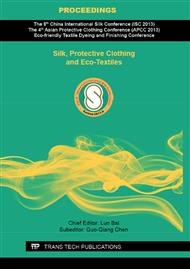p.259
p.264
p.268
p.272
p.277
p.281
p.286
p.290
p.294
Testing the Blend Ratio of Cashmere/Wool Yarns by Object Extraction Method
Abstract:
The testing of the blend ratio of cashmere/wool yarns is mainly depended on human-powered. It introduced the colors divergence of two fibers using HI-1 dye to stain into the blend yarn of wool and cashmere. The colored samples were then, sliced and imaged. Both the cashmere and wool that have some color information were withdrawn from the background. Then work out the blend ratio according to the fiber cross section size. This study demonstrated a speedy and accurate approach to analysis blend ratio.
Info:
Periodical:
Pages:
277-280
Citation:
Online since:
September 2013
Authors:
Keywords:
Price:
Сopyright:
© 2013 Trans Tech Publications Ltd. All Rights Reserved
Share:
Citation:


